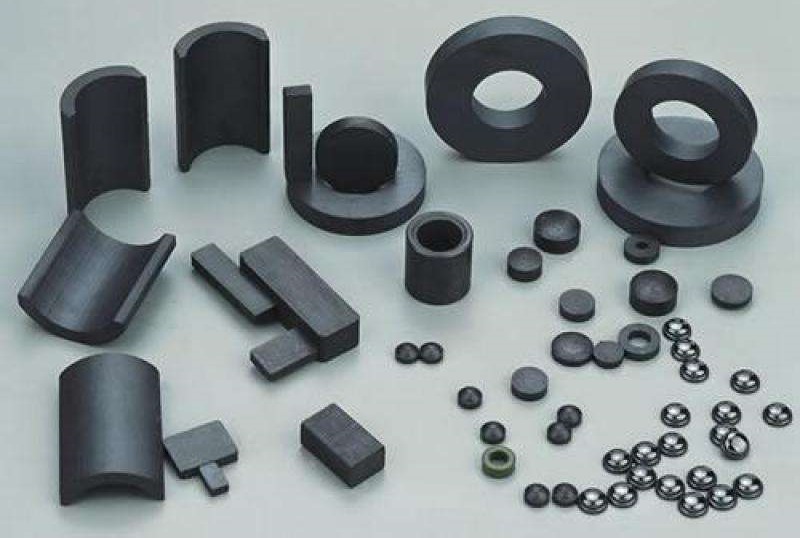Manufacturing Methods Of Ceramic Magnets
Ceramic magnets are referred to as ferrite magnets. Iron, a ferromagnetic metal, makes up the majority of all ceramic magnets. In the 1960s, ferrite magnets were created as a less expensive alternative to metallic magnets. Iron oxide and strontium carbonate make them up. Ceramic magnetics aren't commonly made of raw iron chunks that are solid. They need to be manufactured. The methods of manufacturing ceramic magnets will be explained later in this article. Ceramic magnets have gained widespread popularity due to their corrosion and demagnetization resistance as well as their low cost per pound. Although the hard and brittle nature of ceramic magnets excludes them from a few applications, more than 75% of magnets consumed worldwide are ferrite (by weight). It is the top option for the majority of DC motors, magnetic separators, magnetic resonance imaging, and automotive sensors. There are a lot more uses for ceramic magnets as permanent magnets because of their low cost.
Manufacturing Methods Of Ceramic Magnets
The manufacturing of ceramic magnets involves powder technology methods. Iron oxide and strontium carbonate are the main raw ingredients used to manufacture ferrite. After combining these materials, they are heated to a temperature between 1800 and 2000 Fahrenheit degrees. They go through a chemical transformation at this temperature, and the end product is ferrite. The ferrite material is subsequently wet-milled into extremely tiny particles. Following that, the ground powder is either dried (for dry-pressed material) or pumped into a die (in wet slurry form) in a sizable hydraulic press. Non-magnetic steel with carbide liners occupies the die. The shape of the ferrite material to be pressed is influenced by the die cavities.
Dry Pressed Ferrite Material
In this method, the ground powder from above is compressed dry, producing an isotropic magnet with poorer magnetic characteristics but higher dimensional tolerances. A dry-pressed magnet frequently doesn't need finishing ground.
Wet Slurry Ferrite Material
The powder material is combined with water to create a slurry in this second process. A magnetic field and a die are used to condense the slurry. An anisotropic magnet with higher magnetic characteristics is produced by the applied field, but finishing is frequently necessary.  Next, a magnetic field is used to compact the wet powder (slurry). The flat ferrite particle may more easily align itself in the magnetic field thanks to the water. During the process of compaction, the majority of the water is removed. During the earliest stages of the sintering process, the residual water is evaporated. At a temperature of roughly 2000 degrees Fahrenheit, sintering occurs. The material is fully dense and prepared for finishing grinding to the customer's specifications after sintering. All grinding for ceramic magnets is done with diamond wheels due to the material's extreme hardness and brittleness.
Next, a magnetic field is used to compact the wet powder (slurry). The flat ferrite particle may more easily align itself in the magnetic field thanks to the water. During the process of compaction, the majority of the water is removed. During the earliest stages of the sintering process, the residual water is evaporated. At a temperature of roughly 2000 degrees Fahrenheit, sintering occurs. The material is fully dense and prepared for finishing grinding to the customer's specifications after sintering. All grinding for ceramic magnets is done with diamond wheels due to the material's extreme hardness and brittleness.
Characteristics Of The Ceramic Materials
- * Ceramic magnets are the cheapest substance available in comparison to rare-earth and alnico magnets. Alnico magnets have a lower service temperature while rare earth has a higher one.
- * Due to their production process, they are only available in simple shapes.
- * Ceramic magnets have strong intrinsic coercive force.
- * A diamond cutting or grinding wheel is needed for finishing. Tooling may be costly.
- * Compared to alnico and rare earth magnets, they have lower energy output.
- * The most popular ceramic grades are 1, 5, and 8. (1-8 possible) with grade 8 being the strongest ceramic material in the market.
Ceramic Magnets Application
There are numerous applications for ceramic magnets.
- * Both DC permanent magnet motors used in automobiles and DC brushless motors used in power tools are powered by ceramic magnets.
- * They are also utilized in the magnetic separation of equipment in the industry to separate ferrous metal material from non-ferrous metal material.
- * Ceramic magnets are also applied in the manufacturing sector to lift, hold, retrieve, and separate materials using magnetic assemblies.
- * Ceramic magnets are used in speakers, vehicle sensors, and other devices. These magnets may be enclosed within a channel in specific applications to boost the magnet's strength.
- * Ceramics are a very popular choice for educational activities, home repair, and other things among the general consumer.
- * These affordable magnets are excellent for science lessons and provide children with a pleasant, hands-on approach to learning scientific principles.
- * Ceramic magnets can be used in the home to hang decorations, implement smart DIY projects, and create inventive storage solutions.
- They are helpful for arts and crafts projects as well.
Conclusion
Ceramic magnets have become increasingly popular in modern industries due to their high energy content and unique properties. Ceramic magnets come in a wide range of forms and sizes and offer dependable strength. These magnets are not only inexpensive but also lightweight and demagnetization-resistant. Thank you for reading and we hope it can help you to have a better understanding of ceramic magnets. If you want to learn more about magnetic materials, we would like to advise you to Stanford Magnets for more information.














